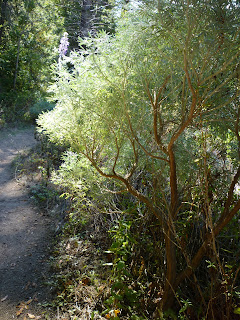
Have you ever seen a fresh pimiento pepper for sale in the grocery store? No? That's why, if you have a garden, you should consider growing them yourself. The little jars of diced pimientos that are the only experience most people have of them -- sorry, but they are not to be compared to the fruits you can expect to harvest from your back yard.


I went around the garden this afternoon snapping pictures of the prettiest things, including the peppers.
What first caught my eye was the way the color of the Mexican Sage coordinated so nicely with the Red Russian Kale. Some parsley is peeking up at the bottom.
Arugula (with the white flower) is a real self-starter and has come back up through the basil, and the nasturtiums are still going strong.
But about those pimientos: It was about 30 years ago I encountered a fellow gardener's planting of them, on a sunny hillside growing alongside beans and tomatoes and other more common things. Ellie said, "Pimientos are marvelous; they are good with everything. We just love them!" It was at a time in my life when I was very suggestible regarding any homemaking idea, and the garden was a big part of my homemaking.
Since then, I don't think a year has gone by that we didn't grown some pimientos, though one time we ended up with some plants that had an odd shape and slightly different flavor. That's when we learned that there are different varieties called pimiento. But the shape of the fruits in my photos here is what we think of as standard.
Pimientos have a richer taste than the standard sweet red bell pepper that the supermarkets carry, and the wall of the fruit is probably twice as thick. For 20+ years I would mostly serve them sautéed with mushrooms and/or onions and garlic as a vegetable dish. The skins would often slide off before I got the skillet to the table, in which case sometimes I'd sometimes manage to remove some of them. Mostly the skins got eaten.
But now that I have a gas range I can easily turn them around on the stove with tongs while they hiss and sputter, and have fire-roasted peppers. (I also did this with poblano peppers this summer.) After they are blackened all over, you stick them in a bowl or something with a lid -- I tried a plastic bag but the peppers were so hot they melted holes in the bag -- and let them sweat a few minutes until the skins rub off easily under water.
Meanwhile, the house starts to smell like a Mexican restaurant!
Once they are bare and thick slabs of sweet flesh, it is so easy to chop some up into soups or stews or salads. Lay a pepper on top of bread and cheese, or just bread...or feel really indulgent eating one all by itself. I freeze some flattened between waxed paper to use all year long.




































